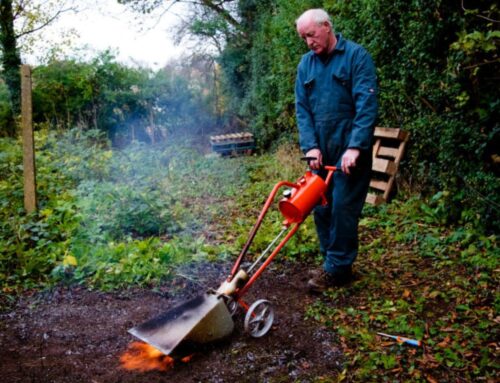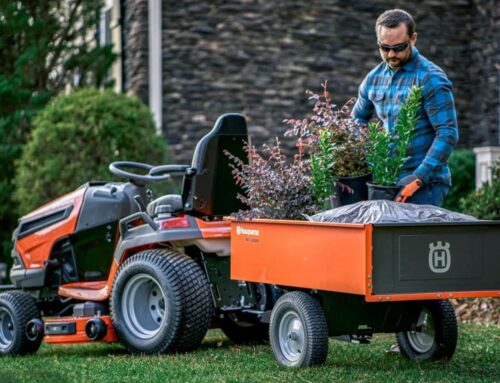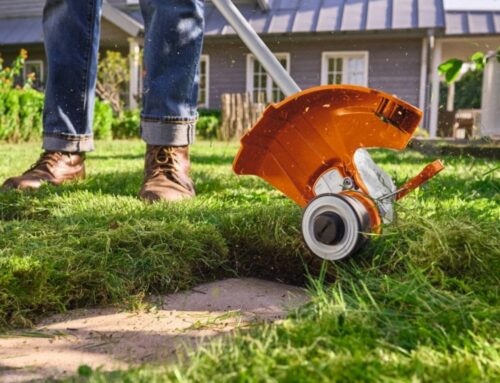
TLDR: Clean gutters in autumn to prevent water damage; use leaf blowers, vacuum‑shredders or pressure washers with gutter attachments (ground‑reach kits avoid ladders) and pipe‑cleaning hoses for downpipes. Check annually—or more if trees—and use proper PPE; tools and kits available from Ron Smith & Co.
How to Use a Blower or Pressure Washer to Clean Gutters & Pipes
Autumn brings a certain charm to the garden, but it also presents a seasonal challenge: an increased risk of blocked gutters and drainpipes. Keeping these vital parts of your home’s drainage system clear is essential, not just for appearances, but for protecting your property from serious damage.
In this guide, we’ll begin by explaining the importance of keeping your guttering clean, and why autumn is the best time of year to carry this work out. We’ll then reveal how to clean gutters effectively using leaf blowers, vacuum shredders, and pressure washers, when paired with their respective gutter cleaning accessories.
Why Clean Gutters in Autumn?
 It’s easy to overlook gutters until they overflow, but by then, the damage may already be done. Gutters channel rainwater from your roof, guiding it safely away from the walls. When leaves, moss, and twigs build up inside them, the flow of water is disrupted, causing overflows that can lead to damp, cracked plaster, and even damage to the foundations of your home. In short, a simple clean now, with the right gutter cleaning equipment, could save you costly repairs later.
It’s easy to overlook gutters until they overflow, but by then, the damage may already be done. Gutters channel rainwater from your roof, guiding it safely away from the walls. When leaves, moss, and twigs build up inside them, the flow of water is disrupted, causing overflows that can lead to damp, cracked plaster, and even damage to the foundations of your home. In short, a simple clean now, with the right gutter cleaning equipment, could save you costly repairs later.
Clean gutters also last longer. When left clogged, standing water accelerates corrosion, especially in metal guttering, and can loosen fittings too.
Autumn is the perfect time to carry out this gutter maintenance work because it’s when most of the debris accumulates. Tackling it before winter ensures that rainwater and melted snow can drain freely, protecting your home and keeping the guttering itself intact.
How Do I Clean Gutters Safely and Effectively
Before you start, inspect your gutters for signs of sagging or leaks. Once you’ve ascertained everything’s secure, you can begin the cleaning process with your chosen tool. We recommend using a leaf blower, vacuum shredder, or pressure washer—far quicker and more effective methods for removing debris than an old-fashioned gutter cleaner brush.
How Do You Clean Gutters with a Leaf Blower or Vacuum Shredder?
Blowers and vacuum shredders are powerful tools that make short work of shifting leaves and other organic debris from a gutter. But if you’re working above ground level and don’t have a gutter cleaning attachment, you’ll need to use a ladder. Always ensure it is stable and never overreach.
How to Clean Gutters Without a Ladder
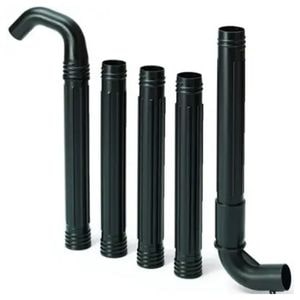 If you’re wondering how do I clean my gutters from the ground, using a leaf blower with a gutter cleaning attachment kit removes the need for ladder work. This is because it includes a series of tubes that attach to the machine to direct air upwards and into the gutter. This transforms blowers into telescopic gutter cleaning tools, offering extended reach and allowing you to access high sections of guttering from the ground.
If you’re wondering how do I clean my gutters from the ground, using a leaf blower with a gutter cleaning attachment kit removes the need for ladder work. This is because it includes a series of tubes that attach to the machine to direct air upwards and into the gutter. This transforms blowers into telescopic gutter cleaning tools, offering extended reach and allowing you to access high sections of guttering from the ground.
When one of these kits is attached to a vacuum shredder, the same principles apply only the leaves are sucked back down the tubes, through the machine, and into its collection bag.
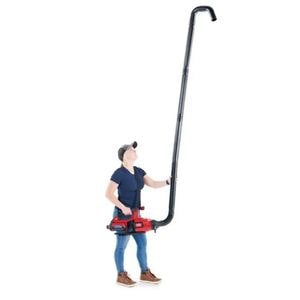 The Benefits of Gutter Cleaning Attachments
The Benefits of Gutter Cleaning Attachments
As you can imagine, specialised gutter cleaning accessories make a big difference in terms of both safety and efficiency. Using what is effectively an extendable gutter cleaning pole allows you to work more safely and reach roof edges with precision to ensure a thorough, even clean.
Another benefit of using rain gutter cleaning attachments is that they reduce physical strain and minimise mess. When paired with the right gutter vacuum cleaner or blower, they make light work of what used to be one of the least appealing household jobs—all with your feet firmly planted on the ground.
How Do You Clean Your Gutters with a Pressure Washer?
 As to how to clean out gutters with a pressure washer, again you’ll need a suitable attachment. Once fitted, a pressure washer gutter cleaner blasts away the most stubborn dirt, algae, and blockages with ease.
As to how to clean out gutters with a pressure washer, again you’ll need a suitable attachment. Once fitted, a pressure washer gutter cleaner blasts away the most stubborn dirt, algae, and blockages with ease.
Begin the job by removing large clumps of leaves or twigs by hand or with a blower. Then attach your pressure washer gutter cleaner attachment—usually a curved or angled lance that lets you comfortably reach into the gutter. Start on a low pressure setting and gradually increase it until the water dislodges the debris and the guttering is clean. This will restore the proper flow of rainwater. Always wear goggles and gloves, and avoid directing the jet towards joints or seams to prevent accidental damage.
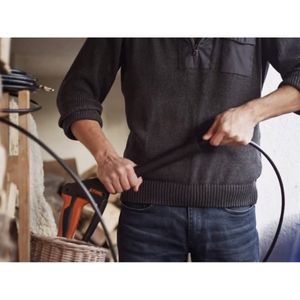 Clearing and Maintaining Drainpipes
Clearing and Maintaining Drainpipes
Cleaning the gutters is only half the job. Once the debris is removed, you should use the pressure washer to clear the drainpipe too.
Using a pressure washer to clear drainpipes requires a pipe-cleaning hose attachment. It is fitted with a jet nozzle and fed into the pipe. When the pressure washer is activated, the hose flushes out leaves, moss, and other obstructions.
If your downpipe empties into an underground drain, be sure to check that the blockage isn’t below the surface. Keeping the full system clear ensures water drains freely and helps prevent damp walls and damaged foundations.
Choosing the Right Gutter Cleaning Tools
Modern gutter cleaning tools have transformed what used to be a slow, messy job into something you can complete efficiently in an afternoon. Whether you choose a leaf blower with gutter cleaning attachment or a pressure washer gutter cleaner, you’ll find that today’s equipment is designed to be extremely user-friendly.
So, in terms of how to clean the gutters from the ground effectively, these innovative systems are your answer. Adjustable, telescopic gutter cleaning tools remove the need for ladders, while their ergonomic designs help you work comfortably.
When selecting your ideal rain gutter cleaning tools, be guided by what best suits your home’s layout, your comfort zone, and the nature of the debris:
- Leaf blowers are very easy to operate and excellent for dry debris. They can be used from ground level when paired with gutter cleaning kits.
- Gutter vacuum cleaners offer the same advantages, with the added benefit of collecting the debris. They also tend to be more effective on wet leaves and compacted material.
- Pressure washers fitted with power washer gutter cleaner attachments are the best tools for deep cleaning guttering and clearing drainpipes.
- Rain gutter cleaning brushes offer you a manual option for precise but labour-intensive cleaning.
How Often Should You Clean Your Gutters?
The answer to this largely depends on your surroundings. In most areas, once a year is sufficient—ideally in autumn. However, if your home is surrounded by trees, you may need to check your guttering more often.
Autumn is particularly important because of falling leaves and the wetter weather. By cleaning at this time of year, you prepare your home for winter and protect your roofline from the damage caused by overflowing gutters.
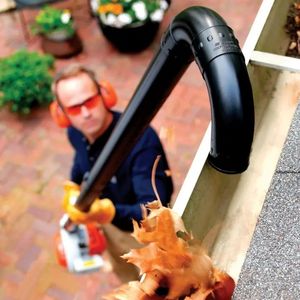 You’ll Find the Best Gutter Cleaning Tools Here
You’ll Find the Best Gutter Cleaning Tools Here
At Ron Smith & Co, we sell a comprehensive collection of gutter tool cleaners. This includes a superb range of blowers and vacuums, together with their gutter cleaning attachment kits. We also sell high-quality pressure washers—ideal for this kind of work when paired with purpose-built gutter cleaning accessories.
And if you have any further questions about how to clean outside gutters using these tools, our experienced team is always on hand to help. They can match you with the best tool to clean out gutters at your own property, so you can keep your guttering and drainpipes flowing freely all year round.


